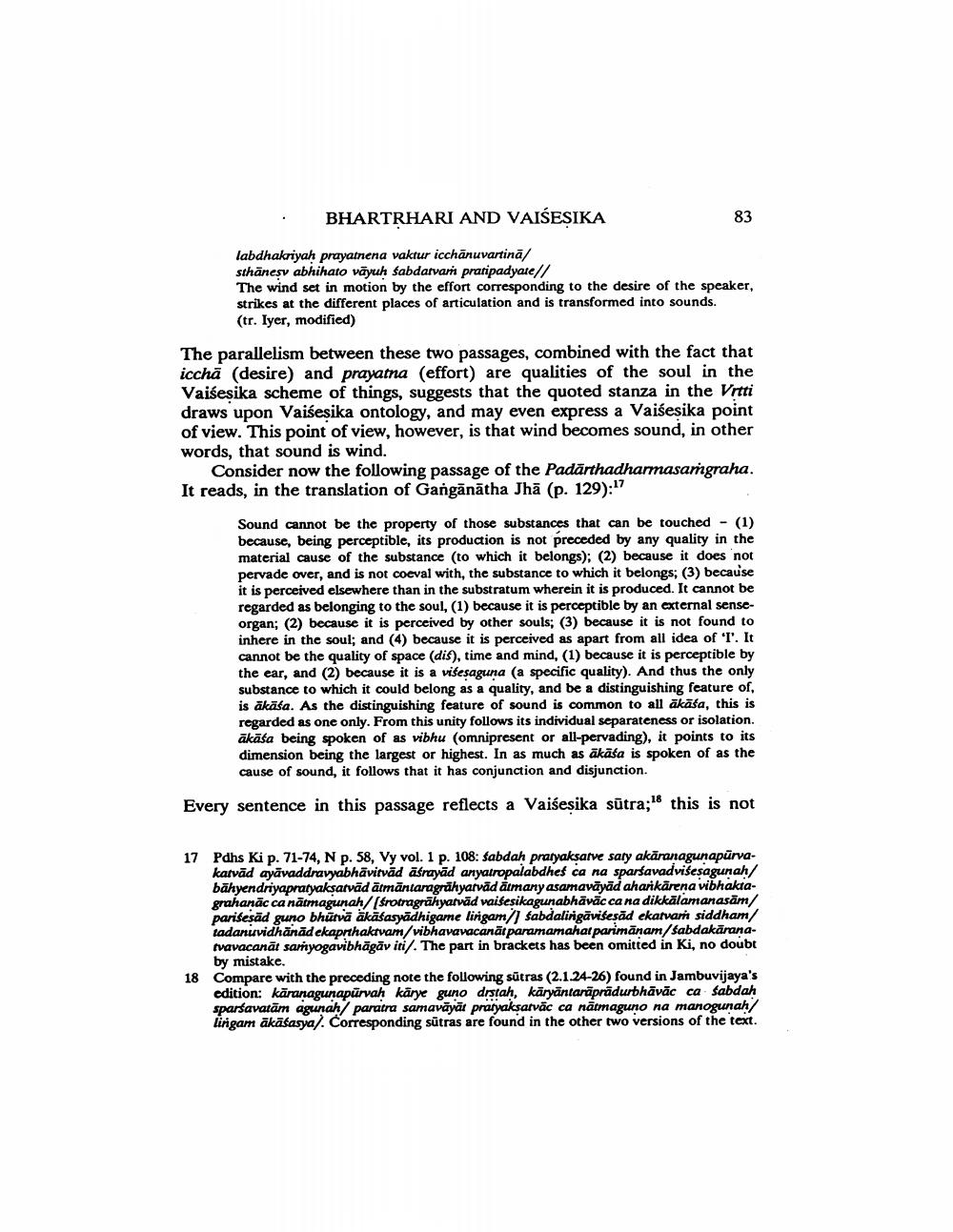________________
BHARTRHARI AND VAIŠESIKA
83
labdhakriyah prayatnena vaktur icchānuvartinā/ sthänesy abhihato vāyuh sabdarvari pratipadyate// The wind set in motion by the effort corresponding to the desire of the speaker, strikes at the different places of articulation and is transformed into sounds (tr. Iyer, modified)
The parallelism between these two passages, combined with the fact that icchā (desire) and prayatna (effort) are qualities of the soul in the Vaišesika scheme of things, suggests that the quoted stanza in the Vrtti draws upon Vaiśesika ontology, and may even express a Vaiśesika point of view. This point of view, however, is that wind becomes sound, in other words, that sound is wind.
Consider now the following passage of the Padārthadharmasargraha. It reads, in the translation of Gangānātha Jhā (p. 129):17
Sound cannot be the property of those substances that can be touched - (1) because, being perceptible, its production is not preceded by any quality in the material cause of the substance (to which it belongs); (2) because it does not pervade over, and is not coeval with, the substance to which it belongs; (3) because it is perceived elsewhere than in the substratum wherein it is produced. It cannot be regarded as belonging to the soul, (1) because it is perceptible by an external senseorgan; (2) because it is perceived by other souls; (3) because it is not found to inhere in the soul; and (4) because it is perceived as apart from all idea of 'I'. It cannot be the quality of space (dis), time and mind, (1) because it is perceptible by the ear, and (2) because it is a visesaguna (a specific quality). And thus the only substance to which it could belong as a quality, and be a distinguishing feature of, is ākāsa. As the distinguishing feature of sound is common to all äkāśa, this is regarded as one only. From this unity follows its individual separateness or isolation. ākāśa being spoken of as vibhu (omnipresent or all-pervading), it points to its dimension being the largest or highest. In as much as ākāśa is spoken of as the cause of sound, it follows that it has conjunction and disjunction.
Every sentence in this passage reflects a Vaiśesika sūtra;18 this is not
17
Pdhs Ki p. 71-74, N p. 58, Vy vol. 1 p. 108: sabdah pratyaksarve saty akāranagunapūrvakatvād ayāvaddravyabhävitvad asrayād anyatropalabdhes ca na sparsavadvisesagunah/ bāhyendriyapratyaksarvādātmāntaragráhyatvādātmany asamavāyād aharikārena vibhaktagrahanāc ca nātmagunah/ (frotragrāhyatvād vaibesikagunabhāvác ca na dikkālamanasām/ parisesad guno bhütvä äkātasyādhigame lirigam Sabdalirgāvisesād ekatvarn siddham/ tadani vidhănādekaprthaktvam/vibhavavacanāt paramamahat parimānam/sabdakāranatvavacanāt sarnyogavibhāgāv iti/. The part in brackets has been omitied in Ki, no doubt by mistake. Compare with the preceding note the following sūtras (2.1.24-26) found in Jambuvijaya's edition: kāranagunapürvah kärye guno drstah, kāryāntaräprădurbhāvāc ca sabdah sparsavatām agunah/ paratra samavāyāt pratyaksatvāc ca nātmaguno na manogunah/ lirigam ākāśasya). Corresponding sutras are found in the other two versions of the text.
18




